
Vaccinium vitis-idaea, the lingonberry, partridgeberry, mountain cranberry or cowberry, is a small evergreen shrub in the heath family Ericaceae, that bears edible fruit. It is native to boreal forest and Arctic tundra throughout the Northern Hemisphere, from Europe and Asia to North America. Lingonberries are picked in the wild and used to accompany a variety of dishes in Northern Baltoscandia, Russia, Canada and Alaska. Commercial cultivation is undertaken in the U.S. Pacific Northwest and in many other regions of the world.

The Luna moth is a Nearctic moth in the family Saturniidae, subfamily Saturniinae, a group commonly known as giant silk moths. It has lime-green colored wings and a white body. The larvae (caterpillars) are also green. Typically, it has a wingspan of roughly 114 mm (4.5 in), but can exceed 178 mm (7.0 in), making it one of the larger moths in North America. Across Canada, it has one generation per year, with the winged adults appearing in late May or early June, whereas farther south it will have two or even three generations per year, the first appearance as early as March in southern parts of the United States.

The geometer moths are moths belonging to the family Geometridae of the insect order Lepidoptera, the moths and butterflies. Their scientific name derives from the Ancient Greek geo γεω, and metron μέτρον "measure" in reference to the way their larvae, or "inchworms", appear to "measure the earth" as they move along in a looping fashion. A very large family, it has around 23,000 species of moths described, and over 1400 species from six subfamilies indigenous to North America alone. A well-known member is the peppered moth, Biston betularia, which has been subject of numerous studies in population genetics. Several other geometer moths are notorious pests.

The small fan-footed wave is a moth of the family Geometridae. The species was first described by Johann Siegfried Hufnagel in 1767.

The small dusty wave is a moth of the family Geometridae first described by Franz von Paula Schrank in 1802. It is found throughout Western, Central and Northern Europe. In the north, its range extends as far as Denmark and southern Scandinavia. In the east its range extends as far as Russia. Idaea seriata is replaced by the subspecies Idaea seriata canteneraria, from the north-east of Spain and the central and eastern Mediterranean to the Crimean peninsula, while the western Mediterranean and the Balearic Islands are inhabited by the sister species Idaea minuscularia. Outside Europe it is found in eastern Algeria, Tunisia, Turkey, Cyprus, the Caucasus and the northwest of Transcaucasia. In Morocco and western Algeria, it is replaced by the sister species Idaea minuscularia. In the British Isles it is common in England and Wales but is only found in the eastern half of Scotland and it is rare in Ireland.

Idaea dimidiata, the single-dotted wave, is a moth of the family Geometridae. It is a Holarctic species.

Idaea muricata, the purple-bordered gold, is a moth of the family Geometridae. It was first described by Johann Siegfried Hufnagel in 1767 and is found in the Palearctic.

Idaea subsericeata, the satin wave, is a moth of the family Geometridae. The species was first described by Adrian Hardy Haworth in 1809. It is found from central and southern Europe, North Africa, Asia Minor to Transcaspia.
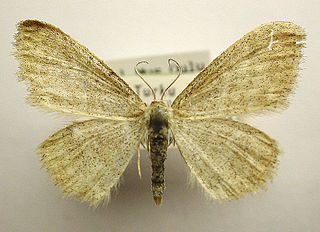
Idaea pallidata is a moth of the family Geometridae. It is found from northern and central Europe to the Caucasus, central Asia and the Amur Region.
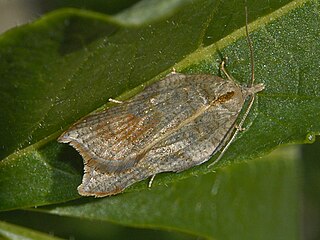
Acleris emargana, the notched-winged tortricid, is a moth of the family Tortricidae. The species was first described by Johan Christian Fabricius in 1775.
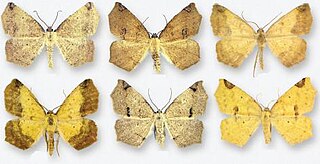
Antepione thisoaria, the variable antepione, is a moth of the family Geometridae. In Canada it is found from Nova Scotia to Manitoba, south into the United States south and west to the Gulf states, as well as Michoacan in Mexico and further south to Costa Rica and Guatemala.

Idaea flaveolaria is a moth of the family Geometridae first described by Jacob Hübner in 1809.
Coleophora idaeella is a moth of the family Coleophoridae. It is found from Fennoscandia and northern Russia to the Pyrenees and the Alps and from Great Britain to Poland.
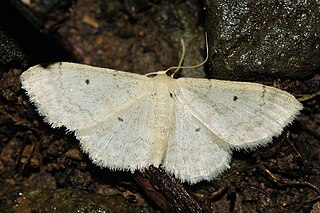
Idaea mancipiata is a moth of the family Geometridae. It is found in Europe und western Asia.
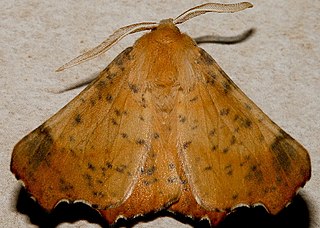
Ennomos magnaria, the maple spanworm moth, notched wing moth, notched-wing geometer or notch-wing moth, is a moth of the family Geometridae. The species was first described by Achille Guenée in 1858. It is found from coast to coast in southern Canada and the northern United States, south in the east to Florida and Louisiana and in the west to California.
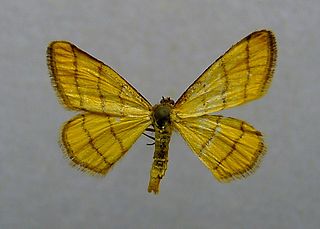
Idaea aureolaria is a species of moth of the family Geometridae. It is found from Spain and France through central Europe to the Balkan Peninsula and east to Siberia. It is also found from Turkey to Central Asia.

Idaea eugeniata is a moth in the family Geometridae. It is found in Italy, France, Andorra, Spain, Portugal and North Africa.
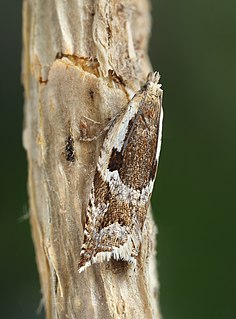
Ancylis myrtillana is a moth of the family Tortricidae. It was described by Treitschke in 1830. It is found in most of Europe and across the Palearctic.It has also been recorded in North America. The habitat consists of moorland.

Acleris lipsiana is a species of moth of the family Tortricidae. It is found in Great Britain, Spain, France, Belgium, the Netherlands, Germany, Denmark, Austria, Switzerland, Italy, the Czech Republic, Slovakia, Hungary, Poland, Greece, Norway, Sweden, Finland, the Baltic region and Russia. It is also found in North America, where it has been recorded from Alberta and Washington. The habitat consists of high moors and mountainous areas.
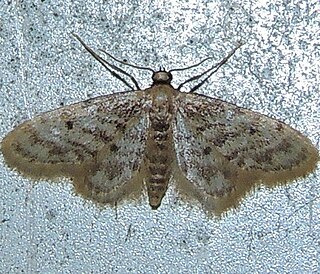
Idaea bonifata is a moth in the family Geometridae. It is found in North America, where it has been recorded from Arizona, California, Georgia, Illinois, Kentucky, Maryland, Nevada, New Mexico, Oklahoma, Pennsylvania, Tennessee and Utah.



















